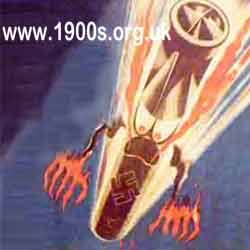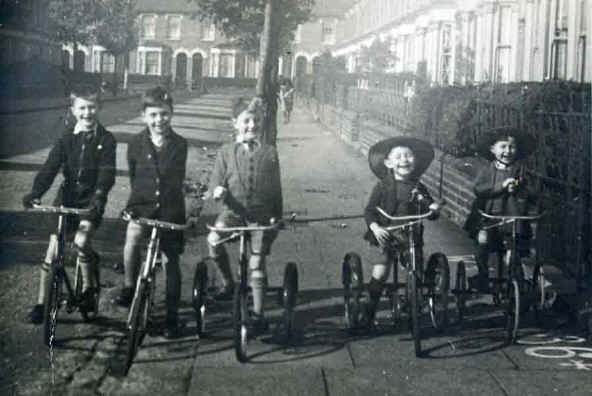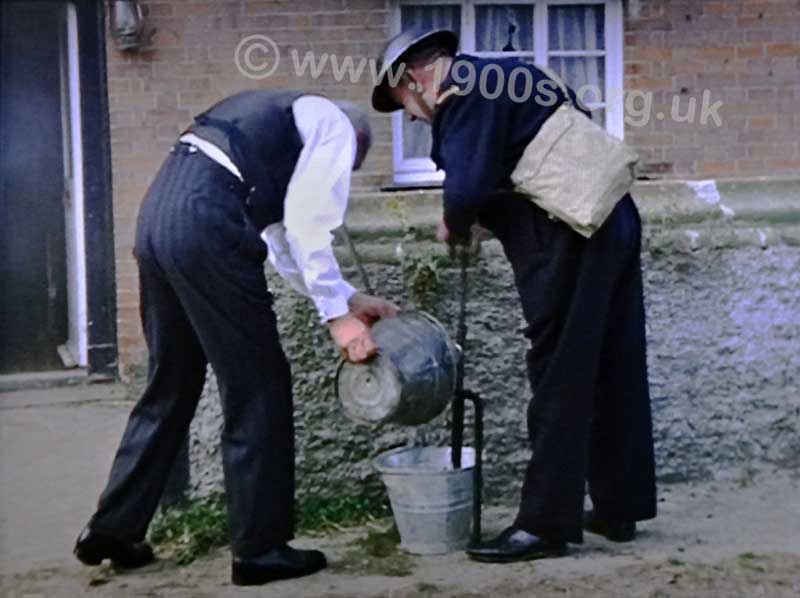
The WW2 home front fights against fire bombs/incendiary bombs

Incendiary bombs also known as fire bombs cause fires. Being small, the quantity dropped in any one WW2 air raid was large and the resulting number of fires was daunting. This page describes how the bombs worked and the steps taken to counter their damage. It details overnight firewatching to spot the fires early and the steps taken to put them out. The emphasis is on how ordinary people coped at the time, and a feature is the contributions of firsthand firefighting experiences.
____
By the webmaster based on research in museums and contributions from people alive at the time
How incendiary bombs worked
Incendiary bombs, also known as fire bombs, held two inert substances which, when brought together produced extreme heat and fire through a chemical reaction. Their impact on landing was normally enough to bring the two substances together, although small explosives were later added to ensure success. Fortunately these bombs did not, themselves, explode, but the extreme heat that they produced caused most of what they came in contact with to catch fire or melt, as well as causing cause excruciating burns on the skin.
According to Wikipedia, the German aircraft carried the bombs in large racks, holding up to 700 bombs. The racks were emptied over targets and themselves remained on the aircraft.
The German targets were necessarily populated areas and their missions were always at night to minimise being seen and shot down by Britain's anti-aircraft guns. At that time, the only sure way for a pilot to know that he was over a populated area was to see a light below which was why strict blackout was so essential.
A personal recollection of the effects of a fire bomb
It is difficult for people who were not alive at the time to understand the fear that everyone had for fire bombs. Perhaps the following firsthand recollection my help.
One Sunday morning in WW2, I was walking with my father along Fore Street, Edmonton. A stick of incendiary bombs had evidently fallen on the houses and the flats above the shops along the east side of Fore Street. These had penetrated the roofs and had landed inside the houses.
A burning mattress had been heaved out of an upstairs window and had landed on the pavement. The residents of that house had acted quickly, so presumably no one was hurt, but they had lost their bed and there was a hole in the roof down to the bedroom. It was a rude awakening for me to see this, even though I was only a child at the time!
John Cole
The first line of defence against fire bombs: fire watching
The fires could be put out relatively easily if they were treated quickly - more of which below. The problem was spotting them immediately they occurred and getting help to them quickly, bearing in mind that it was not the odd one or two fires: it was that the bombs were dropped in large numbers.
The solution - an unpleasant but essential one for the British home front - was that groups of local men, and occasionally women, were put on rotas to stay up at night to watch out for the fires as soon as they occurred. This meant going without sleep, sometimes for the entire night and being positioned for a good vantage point out of doors and high up where the wind, cold and rain were at their worst. My father was stationed on the flat roof of some tall local flats.
Personal experiences of WW2 fire watching
The following firsthand recollections capture the emotion of fire watching better than I could, as I was a small child at the time. Do read on:
The experience of a good vantage point over the City of London
My father worked at the head office of the Abbey Road Building Society, (later to become Abbey National) at the top end of Baker Street, London. The building had a tower about five storeys up, and this was the look-out position for the fire watchers, of whom my father was one. He sometimes took me with him, which involved an all-night stint looking out over the local area of London, and presumably alerting the authorities as necessary. Imagine watching the London Blitz from that vantage point!
John Cole
Lack of sleep with no remit
My father was employed in an engineering factory working 12 hours shifts 6 days a week, and between shifts he was expected to do fire watching on the factory roof.
Peter Johnson
Where we lived, firewatching shifts lasted the entire night, which meant a full day at work, a full night without sleep and then another full day at work. Firewatching shifts may of course have been shorter in other areas.
comment in a group
The punishing vagaries of the weather
Firewatching had to be from a good vantage point which meant being high up and out of doors whatever the weather. My father told the story that he was firewatching on a muddy ridge when he slipped down it and was covered in mud. So he went home to clean up, but once he got there he decided not to bother to go back. Fortunately no-one ever knew because there were no fires that night.
comment in a group
Women did their bit
Firewatching overnight was not just the preserve of men. My mother who was in a reserved occupation had to do fire duty along with the men. I gather that they all huddled together under rather smelly blankets, staying awake at night on the roof of the building where she worked.
Josephine Cock
How firewatchers called for help at locations of fires
The whole point of firewatching was that fires could be put out as early as possible. So, firewatchers had to inform the emergency services about the location of fires. The firewatchers normally had access to a nearly phone because they were necessarily in populated areas, often on the roofs of business premises. I have no evidence of how they would have contacted help quickly without access to a phone, and if you know, please let me know. I assume - but it is only an assumption - that they had to run for help or use morse code with torches.
Ordinary households were not the phone in the 1940s, but no doubt the local Head Warden would have had one installed and could receive emergency calls.
Householders would probably have heard a fire bomb landing on their property, but where not, they needed to be alerted urgently - see the following box.
House numbers on pavements help emergency services locate addresses quickly
During 1942 house numbers were painted on pavements in front of every so-many houses. Presumably this was so that if a row of houses was obliterated they could still be identified. A 'St. John's Ambulance cross' against the number signified a 'first aider'.

Huxley Estate, Edmonton, c1942 showing a house number painted on the pavement - see the lower right of the photo. Note the complete absence of cars and the iron railings still in position prior to removal for the war effort.
John Cole
Instructions on putting the fires out
Because of the large number of fires from any one drop of fire bombs and the urgency of putting them out, the task normally fell to householders, and there was no shortage of information and advice on how to do this. Read on:
The circular on fire precautions in Public Information Leaflet 5
Possibly fullest set of instructions came from Public Information Leaflet 5 which was circulated to every household and which you may like to read now.
However, then as now, people don't always read printed circular. So there were others ways for people to learn what to do when a fire bomb landed.
Instructions with illustrations on cigarette cards
At the time, almost everyone smoked cigarettes and it was the practice for cigarette manufacturers to put what was called a cigarette card inside each packet of cigarettes. These were brightly coloured pictures with information about the pictures on the back. What matters here is that there was a set on air raid protection, and several cards in this theme were on dealing with fire bombs. They were attractive and popular, and would have reached a large number of adults, as well as children who collected them. They are reproduced below, together with their printed instructions - and if you are only scanning this page - are probably the most informative for you.

Putting out an incendiary bomb by scooping it into a portable container. [Remember there were no plastics then.]

Putting out an incendiary bomb with water from a hose pipe.

A type of manual pump for two people. [A stirrup pump]

Carrying water in buckets in a human chain. [It looks as if the buckets are leather.]
Fire drill and the work of the fire brigade
Every able-bodied male had to do fire drill, if only to protect his own house. I can remember my father lying in the street trying to put out a small practice fire with a stirrup pump. He was holding the end of the pipe in one hand and in the other a metal plate with a slit in it to protect his face while another man was pushing and pulling on the pump handle. The pump was standing in a bucket of water.
The fire brigade went around the streets teaching groups of residents this fire fighting drill.
Peter Johnson
Posters to keep fire precautions in mind
There were numerous posters on the war effort and no-one could move far from home without seeing one. However, because of their size, they couldn't give much information. There main achievement was probably to keep fire precautions in mind.
How to use a stirrup pump
Stirrup pumps were essential devices for putting out fire bombs. So here is some more about them.
Every household had to be within easy reach of a stirrup pump and buckets. The pump needed several people to work it: one on the pump itself and others to ferry buckets of water to the pump.

Pumping was extremely hard work and the person doing it had to keep a foot on the base of the pump to keep it still as he or she pushed down and pulled up.
Neil Cryer
To distribute an emergency water supply for firefighting, metal water tanks were erected on high ground where I lived in Scotland, and a system of pipes ran along the side of residential roads, dipping underground at intersections. I had to lift my bike over this pipe every time I left or returned home.
Douglas Adam
sources: early 20th century material
sources: ww2 home front and other material
contact
the webmaster/author/researcher/editor
privacy policy
















